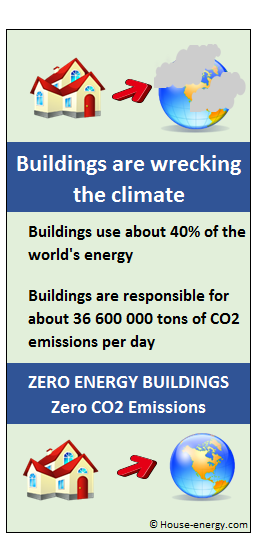Net and Near Zero Energy Buildings
The California Energy Commission, the California Energy Action Plan, the AB 32 Scoping Plan, the Governor’s Clean Energy Jobs Plan, and the Clean Energy Futures Vision all have adopted the goal to achieve Zero Energy Building standards by 2020, for residential homes - and 2030 for commercial buildings.
The Directive 2010/31/EU requires that all “member states shall ensure that by 31 December 2020 all new buildings are nearly zero-energy”. That’s probably the world’s most important energy project.
But the Net Zero Energy Buildings concept is spreading to other countries and parts of the world.
 Definitions of zero energy buildings
Definitions of zero energy buildings
UE definition:
Nearly zero-energy building means a building that has a very high energy performance, as determined in accordance with Annex I. The nearly zero or very low amount of energy required should be covered to a very significant extent by energy from renewable sources, including energy from renewable sources produced on-site or nearby.
California ZNE Residential Action Planning Effort definition:
Note: as we can see, the second definition is more stringent. The EU definition does not require buildings to generate 100% of their energy consumption; but since it requires buildings to be very energy efficient and to have their own renewable system, the goal of 100% will be achievable in most cases.A Zero net energy (ZNE) building produces as much energy as it consumes over the course of a year. These buildings achieve ZNE first through high levels of energy efficiency, and then through the addition of clean, on-site renewable power generation, typically solar PV.
Features of zero buildings
Zero energy buildings are very energy efficient buildings.
They involve:
- airtightness and very high-levels of insulation all over their envelope;
- very windows and exterior doors;
- high efficient lighting and appliances;
- good siting, orientation and landscaping;
- smart design.
These features allow them to reduce their energy needs to very low levels and, accordingly, to have a relatively small solar or other renewable system to meet all their heating, cooling and other energy requirements.
See: Zero Energy Buildings Features
Zero energy buildings: Supplying energy for the Industry and the Transportation sector
Properly constructed and equipped with a solar PV system, or other on-site renewable system, Zero energy buildings can meet all their energy load.
In other words: Zero energy buildings can free-up electricity for the electric vehicles network and for the industry; they may close thousands of coal-fired and nuclear power plants worldwide.
See: Zero Energy Buildings can free-up energy for the Industry and the Transportation sector
Zero emissions
Buildings are the problem. Buildings are the solution!
This slogan, from the Architecture2030 organization tells us a lot about the importance of ZE buildings.
The buildings sector is the largest contributor for climate change. Residential and commercial buildings consume about 40% of the world’s energy (75% of the electricity produced in the USA and 34% of the natural gas are used to operate buildings). Accordingly, ZE buildings are instrumental to stop climate change.
Zero Energy Buildings = Zero CO2 Emissions
Zero Energy Buildings vs. Passive Houses, Green Buildings and Low energy buildings
Zero Energy Buildings, Passive houses, Green buildings...
All these concepts are intertwined. They all describe energy-efficient buildings, designed to consume little energy.
The concept of green and sustainable building stresses specific features, involving construction materials, reduced waste, and the overall impact of the built environment on human health and the natural environment.
But to be sustainable and green, buildings have also to be energy-efficient.
As one of the founders of the Passive House standards – Dr. Wolfang Feist - explains, “a building that produces an energy surplus only in summer doesn’t necessarily have a good energy balance. Photovoltaic systems typically yield little energy in winter, which is exactly when we have peak loads from heating. (…) The heating energy demand itself also has to be very low. The primary consideration with respect to energy will always be: energy-efficiency first. The Passive House Standard is the appropriate solution for this approach.” (PassiveHaus Trust)
Zero energy buildings costs and prices
How expensive are Zero Energy Buildings?
Installing high efficient windows and exterior doors, or high levels of insulation all over the walls and ceiling, costs money.
That's why some estimates indicate that ZEB buildings cost about 8% to 20% more than common buildings.
But it depends also on your choices. You can build an affordable Zero Energy House (cheaper than average homes) if you stick to some basic rules: if you keep the size of the house small or modest, if you choose a concrete slab-on-grade foundation, and so on.
See: Zero Energy Buildings haven't to be pricey.
About to build a new home?
Read our book (Print and Kindle ebook versions);
Save thousands of dollars;
Avoid costly mistakes and pitfalls.
See also:
USA and California Zero Energy Buildings
Europe Near Zero Energy Buildings
Japan & Zero Energy Buildings
China & Zero Energy Buildings
India Zero Energy Buildings
Australia Zero Energy Buildings
More:
Zero Energy Buildings & Architecture and Designers
Local Governments and Zero Energy Building
Zero Energy Building Schools
Zero Energy Buildings Awareness
Zero Energy Buildings & Retrofitting
Zero energy buildings opportunities & partnerships


